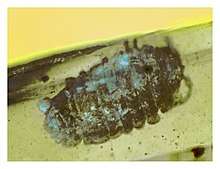Invertebrate iridescent virus 31
Invertebrate iridescent virus 31 (IIV-31), also known informally as isopod iridescent virus, is a species of virus in the family Iridoviridae and genus Iridovirus.[1] Isopods ("woodlice", "pill bugs", "slaters", "roly polies", etc.) serve as natural hosts. The crystaline arrangement of virions in advanced infection causes the isopod's exoskeleton to become iridescent blue or bluish-purple prior to premature mortality, making presence of the virus easy to detect.[2]
| Invertebrate iridescent virus 31 | |
|---|---|
.jpg) | |
| An infected woodlouse (blue) amongst uninfected individuals of typical colouration, Netherlands | |
| Virus classification | |
| (unranked): | Virus |
| Realm: | Varidnaviria |
| Kingdom: | Bamfordvirae |
| Phylum: | Nucleocytoviricota |
| Class: | Megaviricetes |
| Order: | Pimascovirales |
| Family: | Iridoviridae |
| Genus: | Iridovirus |
| Species: | Invertebrate iridescent virus 31 |
| Synonyms | |
| |
Hosts
In a study conducted in Japan, researchers found eight isopod species belonging to six families (Ligiidae, Alloniscidae, Philosciidae, Armadillidae, Porcellionidae, and Armadillidiidae; excluding two unidentified species) are susceptible to infection with Invertebrate iridescent virus 31.[3] In a separate study, Trichoniscus pusillus (family Trichoniscidae) was identified as the most important host for the virus in the Netherlands.[2]
Distribution
This virus has been reported in the literature as having a wide geographic distribution. In particular, it has been recorded from the former Czechoslovakia, France, Italy[4], Japan, the Netherlands, Russia, Turkey, the United Kingdom, and the United States.[3]
Tentative fossil

In a study on early Cretaceous amber from Myanmar, an ancient strain of Invertebrate iridescent virus 31 was tentatively suggested to be the cause of iridescent blue areas present on a fossilised isopod.[5]
References
- "ICTV Master Species List 2018b.v2". International Committee on Taxonomy of Viruses (ICTV). Retrieved 10 October 2019.
- Wijnhoven H, Berg MP (1999). "Some notes on the distribution and ecology of Iridovirus (Iridovirus, Iridoviridae) in terrestrial isopods (Isopoda, Oniscidae)". Crustaceana. 72: 145–156.
- Karasawa S, Takatsuka J, Kato J (2012). "Report on Iridovirus IIV-31 (Iridoviridae, Iridovirus) infecting terrestrial isopods (Isopoda, Oniscidea) in Japan". Crustaceana. 85: 1269–1278. doi:10.1163/15685403-00003116.CS1 maint: multiple names: authors list (link)
- Lupetti, Pietro; Montesanto, Giuseppe; Ciolfi, Silvia; Marri, Laura; Gentile, Mariangela; Paccagnini, Eugenio; Lombardo, Bianca Maria. "Iridovirus infection in terrestrial isopods from Sicily (Italy)". Tissue & Cell. 45 (5): 321–327. doi:10.1016/j.tice.2013.05.001. ISSN 1532-3072. PMID 23756498.
- Poinar Jr. G (2014). "Evolutionary History of Terrestrial Pathogens and Endoparasites as Revealed in Fossils and Subfossils". Advances in Biology. 2014. doi:10.1155/2014/181353.
Further reading
- Lupetti P, Montesanto G, Ciolfi S, Marri L, Gentile M, Paccagnini E, Lombardo BM (2013). "Iridovirus infection in terrestrial isopods from Sicily (Italy)". Tissue and Cell. 45. doi:10.1016/j.tice.2013.05.001.CS1 maint: multiple names: authors list (link)
- Piegu B, Guizard S, Tan YP, Cruaud C, Asgari S, Bideshi DK, Federici BA, Bigot Y (2014). "Genome sequence of a crustacean iridovirus, IIV31, isolated from the pill bug, Armadillidium vulgare". Journal of General Virology. 95: 1585–1590. doi:10.1099/vir.0.066076-0.CS1 maint: multiple names: authors list (link)